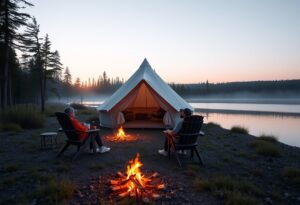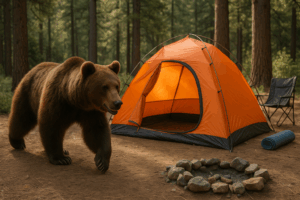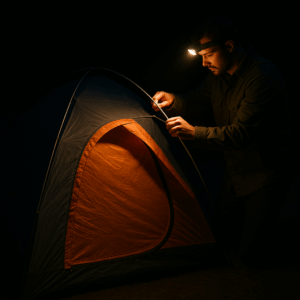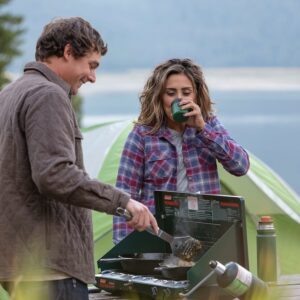Camping in Canada is one of the easiest and most rewarding outdoor adventures—if you avoid these common Camping Mistakes.
Whether you’re a first-time camper or a seasoned pro, small oversights can turn a dream trip into a frustrating ordeal. From unexpected weather shifts to forgotten essentials, even experienced campers make many of these common mistakes.
In this guide, we’ll cover:
✔ The most overlooked camping prep mistakes (and how to fix them)
✔ Must-have gear most people forget (but will save your trip)
✔ Pro tips for picking the perfect campsite (avoid these rookie errors)
✔ Why Canada is one of the best places to camp (easy, scenic, and beginner-friendly)
By the end, you’ll be ready for a stress-free, unforgettable Canadian camping adventure—without the headaches most campers face. Let’s dive in!
Camping is one of the best ways to connect with nature, unwind, and create unforgettable memories. However, even experienced campers sometimes forget crucial details that can make or break their trip. Whether you’re a first-timer or a seasoned outdoors enthusiast, here are some of the most commonly overlooked aspects of camping—plus tips to ensure your Canadian camping adventure is as easy and enjoyable as possible.
1. Camping Mistake #1, NOT Checking the Weather (Beyond Just the Forecast)
Many campers glance at the weather app before leaving but fail to consider microclimates.

In Canada, mountain regions, coastal areas, and forests can have drastically different conditions than nearby cities. Always:
- Look up wind conditions (especially if you’re near large lakes or oceans).
- Be prepared for rain, even if the forecast looks clear—a lightweight tarp or rainfly can save your trip.
- Canada’s wilderness can get much colder at night than expected. Even in summer, mountain and lakeside campsites can drop below 10°C (50°F).
- Pack a sleeping bag rated colder than forecasted temperatures.
- Bring Thermal layers and a warm hat (yes, even in July), for those cooler mornings and evenings.
2. Packing the Right Gear and Testing it Before Your Trip (Not Just the Obvious Stuff)
Obviously, everyone remembers tents and sleeping bags as they are the bare necessities for camping. Before heading off, it is helpful and recommended to do these three things first, to ensure you are not faced with surprises, or blisters, while out on your trip:
- Set up your tent at home first. First-time campers should try a backyard or car-camping trip before venturing into the wilderness.
- Test your stove and headlamp.
- Break in hiking boots before long treks.
Some smaller essentials often get forgotten, but most likely come in handy at one time or another:
- A repair kit (duct tape, extra tent stakes, paracord).
- Biodegradable soap (for cleaning dishes without harming the environment).
- Extra batteries or a portable charger (especially if you rely on GPS or phones for navigation).
- A headlamp (hands-free lighting is a game-changer).
3. Campsite Selection & Setup
Picking the perfect spot isn’t just about the view, be sure to do it right the first time:
- Avoid low-lying areas where water can pool if it rains.
- Look for natural windbreaks (like trees or rocks) if camping in open areas.
- Be aware of potential hazards, like falling trees, unstable banks or slopes.
- Ensure your tent is on level ground—sleeping on a slope is uncomfortable!
- Keep food stored properly to avoid attracting wildlife (especially in bear country).
4. Food & Water Planning
Underestimating food and water needs is a common mistake. The old boy scout motto comes to mind (Always be Prepared!).
- Bring extra water or a reliable filtration system (even if there’s a lake or stream nearby).
- Prep meals in advance to minimize cooking time (foil-pack dinners and one-pot meals are great).
- Plan for an extra meal or two, with non-perishables, just in case weather turns and you have to spend an extra night or two.
- Pack high-energy snacks (nuts, jerky, dried fruit) for hikes.
5. Leave No Trace Principles
Canada’s wilderness is pristine because campers respect it. Litter, trampled plants, and soap in lakes harm ecosystems Make sure to always:
- Pack out all trash (including food scraps).
- Use established fire pits or a camp stove to minimize impact.
- Stay on marked trails to protect vegetation.
- Camp at least 60 meters (200 feet) from water sources.
- Use toilette facilities were provided, or bury your doodies when not.
6. Forgetting a First Aid Kit (Or Not Knowing How to Use It)
Blisters, cuts, and burns happen. When in remote areas, something minor, resulting in an infection can cut a camping trip short. A basic first aid kit should include:
- Bandages, antiseptic wipes, and blister pads.
- Tweezers (for splinters and ticks).
- Pain relievers and any personal meds.
7. Poor Food Storage (Hello, Wildlife Encounters) Can Be A Life Threatening Camping Mistake!
Leaving food out attracts animals—from sneaky raccoons to dangerous bears.

Always:
- Use bear-proof containers or lockers (required in many Canadian parks).
- Never keep food or toiletries in your tent.
- Hang food in a tree if no storage is available.
- Canada has bears, cougars, and moose—know how to react:
- Carry bear spray in grizzly country.
- Make noise while hiking to avoid surprises.
- Store food properly.
8. Not Bringing Enough Lighting
One flashlight isn’t enough when you’re cooking, setting up a tent, or hiking to the bathroom at night. Especially during those early spring or late fall camp outs, when day lengths become shorter. Pack:
- A headlamp (freeing up your hands).
- Lantern or string lights for the campsite.
- Extra batteries or a solar charger.
9. Skipping a Backup Navigation Tool
If you are planning backcountry trips or hikes, be savvy with orientation skills, and don’t strictly rely on technology. Phones die, and GPS signals fail. Always carry:
- A physical map and compass (and know how to use them).
- A backup power bank.
10. Arriving Late to Your Campsite
Scrambling to set up in the dark can be challenging and miserable.

Aim to arrive by mid-afternoon so you can:
- Secure the best spot.
- Set up comfortably before sunset. Pitching a tent in the dark can be a challenge.
- Gather firewood (if allowed) before nightfall.
- Prepare your evening meal and get into that relaxation mode. Afterall, that is the whole point, isn’t it?
11. Overpacking (Or Underpacking) Clothes
Many campers bring too many outfits but forget essentials like:
- Moisture-wicking base layers (cotton = bad when wet).
- A waterproof jacket (even if no rain is forecasted).
- Extra socks (wet feet ruin trips).
It is best to have more clothes than not enough. Bring a variety of clothing, including T-shirts, lighter long sleeve shirts, and warmer ware like sweaters. Quick drying pants are worth while.
12. Not Checking Fire Regulations
A camping trip is not the same without time spend sitting around the camp fire. Plan your trip accordingly, and check your provincial or municipal authorities websites (Like Alberta’s Interactive Wildfire Status Site) in advance of your trip. Many Canadian parks also have seasonal fire bans. Be aware and cautious of dry and or winding conditions and always:
- Check local rules before gathering wood.
- Use a camp stove as a backup.
- Never leave a fire unattended.
13. Forgetting Entertainment
Bad weather or downtime happens. Bring something to occupy your time, and to keep busy if you end up stuck in your tent for longer periods of time:
- A book, cards, or travel games.
- A lightweight fishing rod (if near water).
14. Underestimating Bugs (Canada’s Mosquitoes Are No Joke!)
In some regions, bugs can make camping unbearable. Mosquitoes, black flies, horse flies, deer flies, sand flies, the list goes on. Make no bones about it, not being prepared to deal with the little pests can be one of the biggest camping mistakes one can make! Be prepared and pack:
- Bug spray with DEET or picaridin.
- A mosquito net (for extreme cases).
- Long-sleeve shirts and pants for evenings.
15. Not Securing Your Tent Properly
I recall camping at the Pembina River in Alberta with friends years ago. It was the night the Big Valley Jamboree stage blew down. The kids were tucked in their sleeping bags, when all of a sudden, a gust blew hard and rolled the tent across the campground (with the kids in it!) Wind can turn a poorly staked tent into a kite. Always:
- Use all guy lines and stakes.
- Angle stakes away from the tent for better hold.
- Pitch the tent in amongst natural shelter breaks, like forest edges, but be cautious of dead standing trees that can fall during high wind events.
Why Camping in Canada is Easier Than You Think
Despite these potential pitfalls, Canada is one of the best places to camp. Canada is a camper’s paradise, with well-maintained parks, stunning landscapes, and plenty of resources for beginners:
- National & Provincial Parks offer affordable, scenic campsites with amenities like firewood, clean water, and washrooms.
- Reservations are simple (book online through Parks Canada or provincial websites).
- Wildlife safety is well-managed—parks provide bear-proof bins and guidelines.
- Four-season camping options—from summer lakeside trips to winter backcountry adventures.
Avoiding these 15 camping mistakes ensures a smoother, safer, and more enjoyable trip. Canada’s wilderness is waiting—so pack smart, plan ahead, and get ready for an unforgettable adventure! 🏕️🇨🇦
Final Thoughts
Camping doesn’t have to be complicated. By paying attention to these often-overlooked details, you’ll avoid common pitfalls and enjoy a smoother, more relaxing experience. Canada’s breathtaking landscapes and well-organized camping infrastructure make it the perfect place to embrace the outdoors—so pack wisely, plan ahead, and get ready for an unforgettable adventure!
Would you like recommendations for specific Canadian camping spots? Let me know, and I’d be happy to include some hidden gems!
Happy camping! 🏕️🇨🇦



